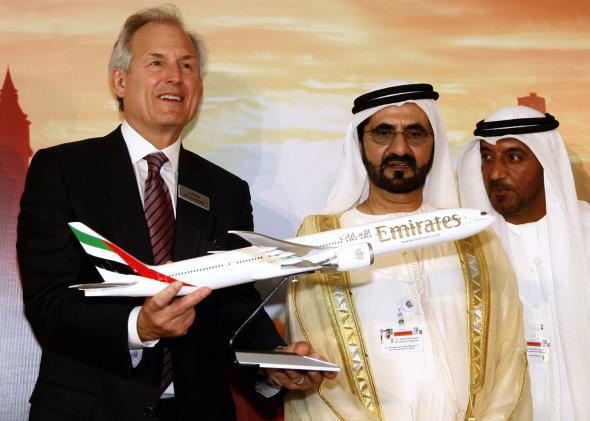The Dubai Airshow is under way this weekend and the announcement there underscore the extent to which growth in the passenger aviation industry is concentrated in the Persian Gulf. Leading the way is Dubai’s own Emirates, which announced plans to spend $20 billion on 50 Airbus 380 superjumbos and another $76 billion on 150 of Boeing’s smaller 777X widebodies. Boeing is selling another 109 of those 77Xes to the region’s other two airlines, Qatar and Etihad which also placed ordered for 30 of its 787 Dreamliners from Boeing. Last but not least FlyDubai said it would buy 100 of Boeing 737 narrowbody jets.
Since Boeing is winning the war for Gulf plane orders, that’s good for American manufacturing and exports.
But it seems to me that the United States could and should be doing more to take advantage of the Persian Gulf aviation boom by allowing what are called “cabotage” or “fifth freedom” flights. Which is to say that Gulf airlines could operate flights that go from one North American city to another North American city rather than exclusively running flights from North America to Dubai, Abu Dhabi, or Qatar.
For example, right now Emirates doesn’t fly to Philadelphia and also doesn’t fly to San Jose presumably because neither of those cities is big enough to fill a jumbo flight to Dubai. And at the same time, no airline offers a direct flight from Philadelphia to San Jose. But perhaps a route that went San Jose - Philadelphia - Dubai would make sense for Emirates somewhat along the lines of their current JFK - Milan - Dubai route. Or there could be a San Diego - Houston - Dubai route that would allow Emirates to connect two cities it doesn’t currently serve while offering some competition to United’s current San Diego - Houston monopoly.
Now of course it might just be that none of the Gulf airlines have any interest in running any routes like that. In which case, so be it. But on the face of it, all three of them seem to be scrambling to expand as aggressively as possible. And traditionally the main barrier to foreign carriers operating domestic routes has been regulatory. Governments have seen their regulatory role as defending the interests of airlines headquartered inside their country. But with airline competition waning in the United States, it’s time for regulators to think about serving passengers by letting the foreigners in.
